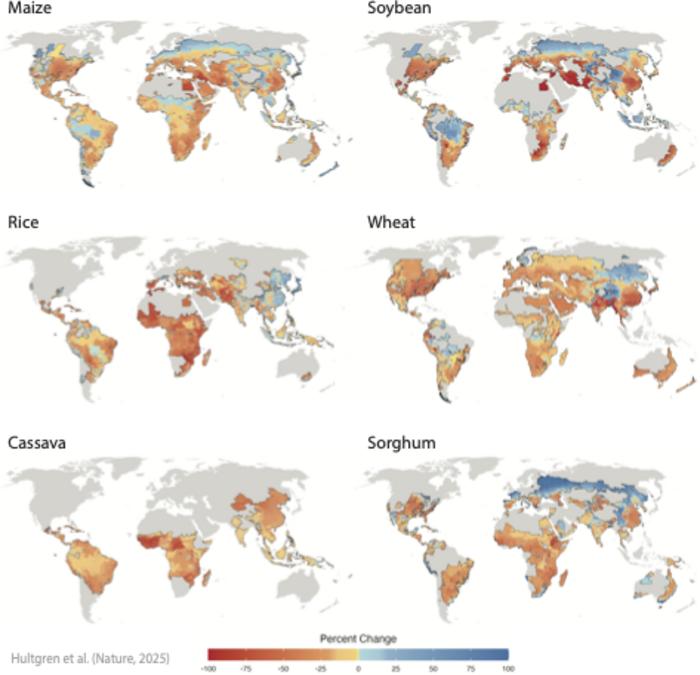A groundbreaking study published in Nature on June 18, 2025, offers the most comprehensive insight yet into the devastating impacts of climate change on global agriculture. Diverging from prior optimism about warming’s potential to boost crop yields, this extensive research reveals a far bleaker future for global food production. By integrating real-world adaptations made by farmers and accounting for socioeconomic shifts, the analysis presents an unvarnished forecast of widespread decline in staple crop yields over the next 80 years, with profound implications for food security worldwide.
The heart of this research lies in quantifying how climate change will reduce the global capacity to produce calories from staple crops such as wheat, corn, rice, soybeans, barley, and cassava—the foundation of two-thirds of human caloric intake. A key discovery is that for each additional degree Celsius of warming, the world’s food output will decrease by approximately 120 calories per person daily. This represents roughly 4.4% of current global calorie consumption, underscoring a direct and alarming link between rising temperatures and nutrition availability.
What distinguishes this study is the meticulous incorporation of farmer adaptation strategies, a critical factor often overlooked or simplified in earlier models. Contrary to assumptions of perfect or zero adaptation, researchers examined how farmers realistically modify practices, including switching crop varieties, adjusting planting and harvesting schedules, and altering fertilizer applications. These adjustments help mitigate losses but only compensate for about one-third of the projected decline in yields by 2100 under high emission scenarios, indicating that adaptation alone will not be sufficient to prevent substantial global food deficits.
The spatial heterogeneity of these impacts reveals striking regional disparities. Highly productive agricultural zones, such as the U.S. Corn Belt, face severe yield reductions under warming futures. Lead author Andrew Hultgren notes that these breadbasket regions—currently among the most fertile and productive globally—could lose their dominant role in feeding populations. Contrastingly, some areas in Canada, China, and Russia may experience yield gains due to their colder climates warming into more favorable agricultural conditions, effectively shifting global agricultural productivity northward.
Yield declines are also uneven across economic lines, with wealthier regions projected to face average losses of 41%, while lower-income regions will see estimated reductions of 28%. These figures highlight the vulnerability of both industrial agriculture and subsistence farming systems, especially those dependent on staple root crops like cassava. The study’s statistical modeling assigns a 70–90% likelihood of yield reductions for most staple crops except rice, which intriguingly may experience a 50% chance of yield increases due to warmer nighttime temperatures that benefit its growth physiology.
Beyond yield projections, the study offers a nuanced understanding of the limits of adaptation under relentless high-emission trajectories. Despite ongoing technological, financial, and behavioral adjustments by farmers, the chronic stresses of heatwaves, droughts, and erratic weather patterns will outpace adaptation capacity. The researchers emphasize that these stressors are already manifesting today as farmers worldwide face increasingly unpredictable growing seasons and increased crop failures despite modern inputs.
Importantly, the research contextualizes global crop yield losses within socioeconomic frameworks. Diminished production translates into higher food prices, reduced affordability, and increased difficulty in accessing sufficient nutrition. Co-author Solomon Hsiang warns of an alarmingly direct consequence: a 3-degree Celsius warming scenario equates to the equivalent global loss of daily breakfast. Such a stark analogy underscores the scale of the challenge facing humanity, especially considering that over 800 million people already experience intermittent hunger due to food insecurity.
The study results originate from an unprecedented dataset spanning more than 12,000 regions across 55 countries, incorporating socioeconomics, historical yield data, climate models, and farmer behavioral responses. This multidisciplinary approach represents a leap forward in climate-agriculture impact assessment, powered by collaboration between leading economists, climate scientists, and agricultural experts within the Climate Impact Lab consortium.
Further raising the stakes, the study projects that by mid-century, crop yields will have declined by approximately 8% irrespective of emission pathway, reflecting the lagged effects of past and present greenhouse gas emissions. Only aggressive mitigation to net-zero emissions would curb this trajectory. Failure to act swiftly will lock in escalating losses reaching 24% by century’s end in the absence of emission reductions, compounding challenges related to population growth and food demand.
In response to these stark findings, the researchers are developing innovative policy tools to guide where and how adaptation investments can be most effectively directed. Collaborating with entities such as the United Nations Development Program, the team is harnessing satellite data and socioeconomic indicators to identify vulnerable communities and prioritize resource allocation. The ultimate goal is to break the feedback loop of climate harm by combining adaptation with urgent emission reductions.
The study also highlights the foundational importance of maintaining soil quality and infrastructure at the local level, which, although necessary, cannot substitute for the climate conditions required for sustained agricultural productivity. Allowing climate degradation to continue unchecked risks rendering fertile farmland unsuitable for future generations, undermining the decades-long investments farmers make to sustain healthy ecosystems.
Together, these findings issue a stark warning and a call to action: the future of global food security hinges on both immediate, aggressive emissions cuts and strategic, science-based adaptation efforts. While some regions may benefit marginally from changing climates, the overwhelming message is clear—unchecked warming will disrupt the delicate balance of global agriculture, with profound consequences for human nutrition and economic well-being worldwide.
Subject of Research: Impacts of climate change on global agriculture considering farmer adaptation
Article Title: Impacts of climate change on global agriculture accounting for adaptation
News Publication Date: 18-Jun-2025
Web References:
References: Adapted from Hultgren et al. (Nature, 2025)
Image Credits: Adapted from Hultgren et al. (Nature, 2025)
Keywords: climate change, global agriculture, crop yields, farmer adaptation, food security, climate impacts, staple crops, emissions scenarios, agricultural economics, crop modeling




